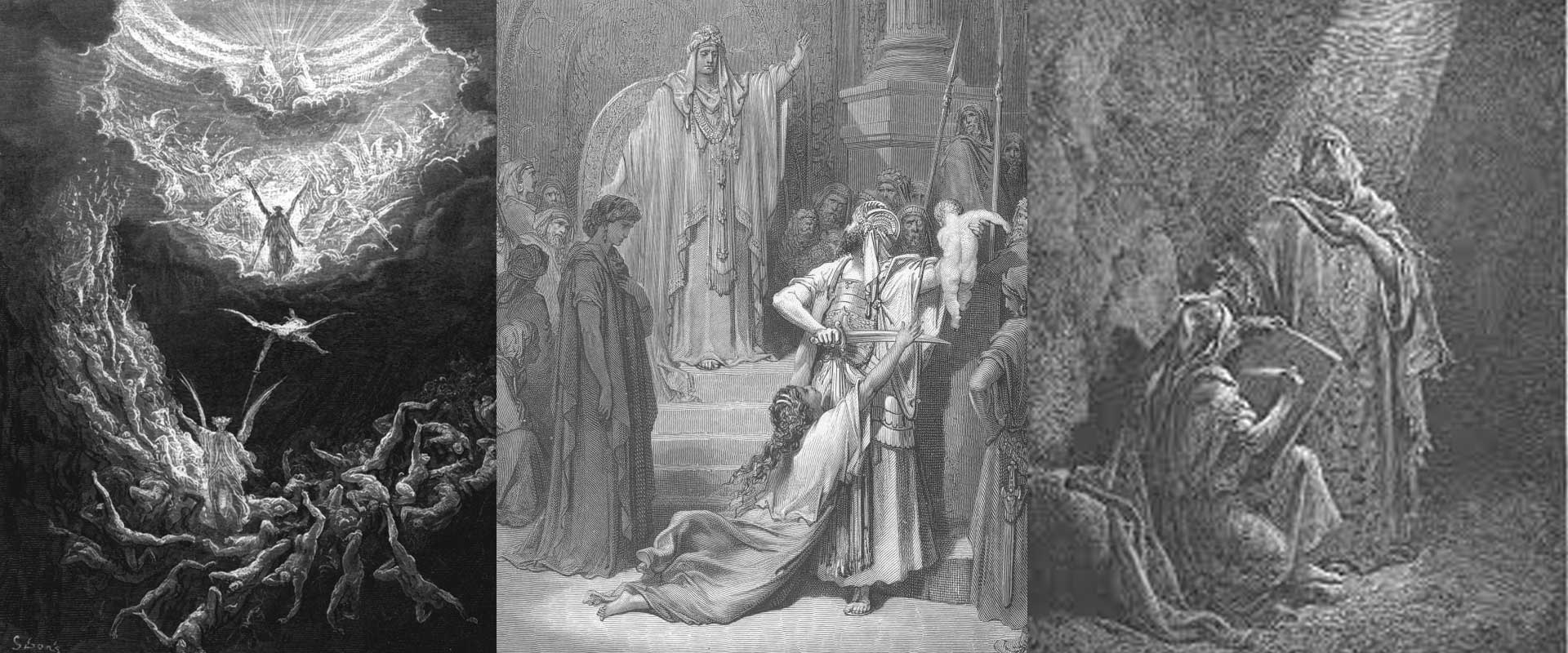Paul Gustave Doré was one of the 19th century’s most prolific illustrators, but among his thousands of works, none are more celebrated than his Bible illustrations. Published in 1866, Doré’s illustrated Bible contained over 200 engravings and quickly became a global phenomenon. His depictions of Creation, the Flood, Moses, the prophets, Christ’s life, and Revelation shaped how millions of people visualized scripture.
What makes Paul Gustave Doré’s Bible illustrations timeless is their ability to transcend mere illustration. They are not simply pictures accompanying text; they are visual sermons, etched in shadow and light, that continue to inspire faith, art, and imagination today.
Doré’s Bible – A Monumental Project
The illustrated Bible was one of Doré’s most ambitious undertakings. Working with a team of engravers, he produced over 200 full-page illustrations. Each image was meticulously crafted, turning sacred passages into dramatic, emotional, and epic visual experiences.
Doré’s engravings covered both Old and New Testament stories. From Adam and Eve leaving Eden to Christ carrying the cross, his art gave readers a sense of awe and intimacy with scripture. The Bible became not only a holy book but also a work of visual art.
Why Doré’s Bible Illustrations Captivate Audiences
Emotional Power
Doré understood that scripture was not only words but experiences of human joy, suffering, and hope. His illustrations captured the sorrow of exile, the terror of judgment, and the triumph of redemption. This emotional depth is why viewers still connect with his art.
Dramatic Contrast of Light and Shadow
Doré mastered chiaroscuro—the interplay of light and darkness. In his Bible engravings, light often symbolizes divine presence while shadow conveys struggle and sin. This visual language makes his art universal, even for those unfamiliar with the texts.
Monumental Scale
Even though they were printed, Doré’s engravings feel monumental. Vast skies, towering mountains, and cosmic visions dominate his compositions. This epic scale gave scripture a grandeur that rivaled Renaissance paintings.
Accessibility
Doré’s Bible was widely printed and affordable compared to fine art. For many households, these engravings became the definitive way of visualizing scripture. They democratized sacred art, making it available to everyday believers.
Themes in Doré’s Bible Illustrations
| Biblical Theme | Doré’s Visual Approach | Impact on Audience |
|---|---|---|
| Creation | Light emerging from darkness, cosmic vastness | Awe and wonder at divine beginnings |
| Judgment & Exodus | Dramatic skies, fleeing crowds, divine wrath | Fear, urgency, and moral seriousness |
| Prophecy | Intense faces, visionary imagery | Spiritual authority and sacred mystery |
| Life of Christ | Gentle yet powerful depictions of compassion | Emotional intimacy and universal resonance |
| Revelation | Apocalyptic visions with cosmic scale | Eternal awe, warning, and hope |
Influence on Religious Art and Devotion
Doré’s Bible engravings were quickly adopted by churches, publishers, and educators. They influenced stained glass designs, devotional cards, and even Sunday school materials. His visual theology gave preachers and teachers powerful tools for storytelling.
Even today, Doré’s tradition continues in works that combine scripture with art. Modern collections such as Bible verse wall art prints echo this practice, showing how timeless the union of word and image remains.
Influence on Modern Illustration and Culture
Doré’s Bible engravings did more than shape devotion—they shaped art history. His dramatic compositions inspired modern illustrators, fantasy artists, and filmmakers. Directors like Cecil B. DeMille borrowed from Doré’s imagery for biblical epics. His apocalyptic visions influenced Gothic and fantasy art.
Much like Paul Gustave Doré’s dramatic Bible illustrations still captivate audiences, his Bible engravings remain reference points for how artists visualize spiritual truth.
Why Doré’s Bible Illustrations Are Timeless
- They blend faith and artistry seamlessly, speaking to both believers and art lovers.
- Their emotional power makes them relevant across centuries.
- Their universality transcends denominational boundaries, appealing to global audiences.
- They continue to influence contemporary artists, from illustrators to filmmakers.
- They capture not only events of scripture but also the eternal themes of human existence—creation, struggle, redemption, and hope.
- Conclusion
Paul Gustave Doré’s Bible illustrations remain timeless because they make the eternal visible. Through light and shadow, drama and intimacy, he turned sacred texts into unforgettable imagery. His engravings do more than illustrate—they interpret, preach, and inspire.
For modern admirers, collections such as Paul Gustave Doré art prints or other spiritual artworks allow Doré’s vision to live on, bringing scripture’s power into daily spaces. His legacy proves that when art and faith unite, the result is truly timeless.
FAQs on Paul Gustave Doré’s Bible Illustrations
Why are Doré’s Bible illustrations considered timeless?
They combine emotional depth, dramatic artistry, and universal symbolism, making them resonate across cultures and centuries.
How many engravings did Doré create for the Bible?
Doré’s illustrated Bible, published in 1866, contained more than 200 full-page engravings covering both Old and New Testament scenes.
What makes Doré’s Bible engravings unique?
His mastery of light and shadow, monumental scale, and ability to convey human emotion made his Bible engravings stand apart from earlier sacred art.
Did Doré’s Bible engravings influence modern art?
Yes. They influenced religious illustration, stained glass, cinematic epics, and even fantasy art. Many artists still study Doré’s Bible engravings today.
Where can I see Doré’s Bible illustrations today?
They are available in libraries, museums, and reprinted editions. High-quality reproductions are also available through curated collections of Doré’s art.





